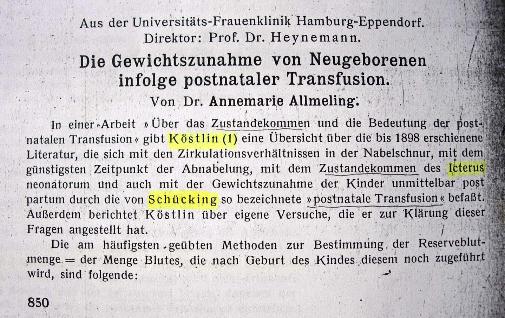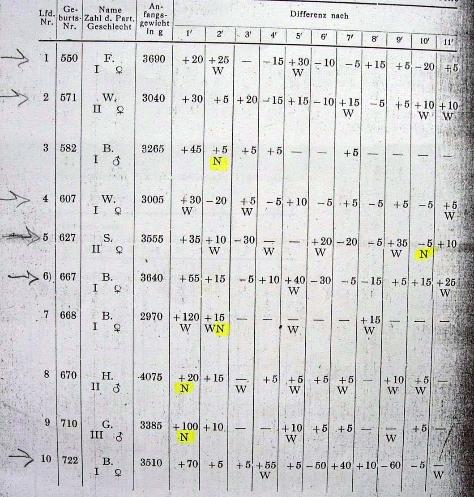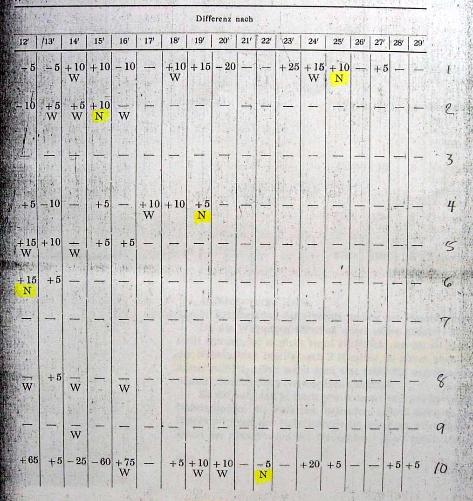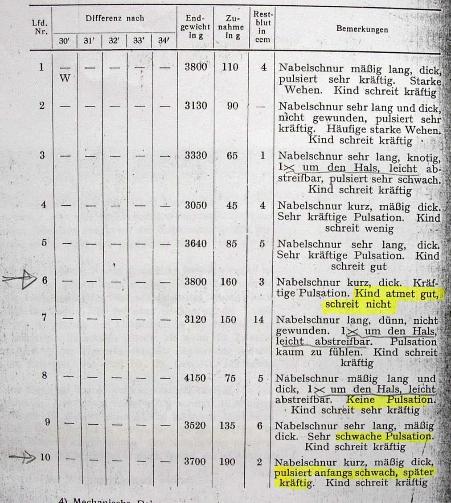Placental circulation continuing after birth,
Allmeling (1930)
Allmeling (1930) measured weight gain in 100 infants
during the period of postnatal transfusion. She also
cited and summarized several research articles that
predated hers by more than 50 years (Kostlin 1898),
Hofmeier 1878). Her work was cited and later
confirmed by Gunther (1957).
Allmeling, like Haselhorst (1929) used a method for
temporary interruption of umbilical cord blood-flow – a
piece of soft rubber tubing with a clamp that could be
removed after obtaining an initial weight of the infant.
She noted that a large amount of placental blood can
be transferred in the first 20 to 30 seconds after
birth. This observation may be the basis others have
used in assuming that a 20 to 30 second delay in
cord clamping is sufficient to allow a full (or nearly full)
placental transfusion – a "one size fits all" mentality.
Of her 100 cases, Allmeling presented 10 in a table
showing maternal parity, gender of the infant, initial
birth weight, and weight fluctuations at 1-minute
intervals up to 34 minutes. Uterine contractions and
time of cessation of pulsation in the umbilical cord
were noted within the 1-minute interval that they
occurred. The end-weight, amount gained, and
residual blood left in the placenta are also shown, with
remarks on the length and appearance of the
umbilical cord, if it were around the neck, and
breathing or crying behavior of the child.
Of her 100 cases, Allmeling presented 10 in a table
showing maternal parity, gender of the infant, initial
birth weight, and weight fluctuations at 1-minute
intervals up to 34 minutes. Uterine contractions and
time of cessation of pulsation in the umbilical cord
were noted within the 1-minute interval that they
occurred. The end-weight, amount gained, and
residual blood left in the placenta are also shown, with
remarks on the length and appearance of the
umbilical cord, if it were around the neck, and
breathing or crying behavior of the child.
To accommodate the 34-minute time span of the table
it was presented in three sections, which are
reproduced below. Most important perhaps is
illustration of the variable time span for continuing
pulsation of the cord (Nabelschnur), designated by
N (and highlighted by me). The W designates Wehe
(uterine contractions), showing their association with
additional gains in weight, which diminish after
pulsations of the cord cease - pulsations of the cord,
from the infant heart, are the primary signal for
continuing need of placental circulation.
Notice that cord pulsations ceased within the first
minute after birth for two infants. For two more,
pulsations stopped within two minutes. After that
pulsations continued for ten, twelve, fifteen, nineteen,
twenty-two, and twenty-five minutes after birth. Why
should placental circulation be arbitrarily cut off within
30 seconds for those infants who require up to 30
minutes continuing connection with their mother?
(in progress - I am grateful to Anne Frye for pointing
out the articles by Haselhorst and Allmeling, which are
in German, so take me a little longer to summarize),
and I am grateful for the paper by Frischkorn and
Rucking (1939), who provided summaries of research
published in German. The first two paragraphs of
Allmeling's paper are reproduced below (after the full
references). I might try putting this and other difficult
to obtain papers online in their entirety.
Allmeling (1930)
Allmeling (1930) measured weight gain in 100 infants
during the period of postnatal transfusion. She also
cited and summarized several research articles that
predated hers by more than 50 years (Kostlin 1898),
Hofmeier 1878). Her work was cited and later
confirmed by Gunther (1957).
Allmeling, like Haselhorst (1929) used a method for
temporary interruption of umbilical cord blood-flow – a
piece of soft rubber tubing with a clamp that could be
removed after obtaining an initial weight of the infant.
She noted that a large amount of placental blood can
be transferred in the first 20 to 30 seconds after
birth. This observation may be the basis others have
used in assuming that a 20 to 30 second delay in
cord clamping is sufficient to allow a full (or nearly full)
placental transfusion – a "one size fits all" mentality.
Of her 100 cases, Allmeling presented 10 in a table
showing maternal parity, gender of the infant, initial
birth weight, and weight fluctuations at 1-minute
intervals up to 34 minutes. Uterine contractions and
time of cessation of pulsation in the umbilical cord
were noted within the 1-minute interval that they
occurred. The end-weight, amount gained, and
residual blood left in the placenta are also shown, with
remarks on the length and appearance of the
umbilical cord, if it were around the neck, and
breathing or crying behavior of the child.
Of her 100 cases, Allmeling presented 10 in a table
showing maternal parity, gender of the infant, initial
birth weight, and weight fluctuations at 1-minute
intervals up to 34 minutes. Uterine contractions and
time of cessation of pulsation in the umbilical cord
were noted within the 1-minute interval that they
occurred. The end-weight, amount gained, and
residual blood left in the placenta are also shown, with
remarks on the length and appearance of the
umbilical cord, if it were around the neck, and
breathing or crying behavior of the child.
To accommodate the 34-minute time span of the table
it was presented in three sections, which are
reproduced below. Most important perhaps is
illustration of the variable time span for continuing
pulsation of the cord (Nabelschnur), designated by
N (and highlighted by me). The W designates Wehe
(uterine contractions), showing their association with
additional gains in weight, which diminish after
pulsations of the cord cease - pulsations of the cord,
from the infant heart, are the primary signal for
continuing need of placental circulation.
Notice that cord pulsations ceased within the first
minute after birth for two infants. For two more,
pulsations stopped within two minutes. After that
pulsations continued for ten, twelve, fifteen, nineteen,
twenty-two, and twenty-five minutes after birth. Why
should placental circulation be arbitrarily cut off within
30 seconds for those infants who require up to 30
minutes continuing connection with their mother?
(in progress - I am grateful to Anne Frye for pointing
out the articles by Haselhorst and Allmeling, which are
in German, so take me a little longer to summarize),
and I am grateful for the paper by Frischkorn and
Rucking (1939), who provided summaries of research
published in German. The first two paragraphs of
Allmeling's paper are reproduced below (after the full
references). I might try putting this and other difficult
to obtain papers online in their entirety.
- Allmeling A (1930) Die
Gewichtszunahme von
Neugeborenen infolge
postnataler Transfusion. - Frischkorn HB , Rucker MP
(1939) The relationship of the
time of ligation of the cord to
the red blood count of the
infant.
- Allmeling A. Die Gewichtszunahme von Neugeborenen infolge
postnataler Transfusion. Zentralbl Gynakol 1930; 54:850-860.
(Zentralblatt für Gynäkologie) - Frischkorn HB , Rucker MP. The relationship of the time of ligation of the
cord to the red blood count of the infant. Am J Ostet Gynecol 1939; 38:
592-594.

Table, part 1, shows maternal parity, sex of infant, initial weight, and the
course of placental transfusion during the first eleven minutes after birth.
course of placental transfusion during the first eleven minutes after birth.

Table, part 2, shows the course of placental transfusion during minutes
twelve through twenty-nine.
twelve through twenty-nine.

Table, part 3, shows minutes 30 through 34 after birth, with only one
patient having a final uterine contraction after 30 minutes. The final
birthweight, total weight-gain (in grams) from placental transfusion, residual
blood in cubic centimeters (cc) left in the placenta, and observations of the
infant, umbilical cord, breathing, and crying.
patient having a final uterine contraction after 30 minutes. The final
birthweight, total weight-gain (in grams) from placental transfusion, residual
blood in cubic centimeters (cc) left in the placenta, and observations of the
infant, umbilical cord, breathing, and crying.
